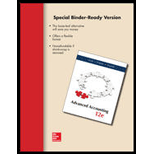
Advanced Accounting (Looseleaf)
12th Edition
ISBN: 9780077632595
Author: Hoyle
Publisher: MCG
expand_more
expand_more
format_list_bulleted
Question
Chapter 11, Problem 13P
To determine
Identify the appropriate answer for the given statement from the options provided.
Expert Solution & Answer
Want to see the full answer?
Check out a sample textbook solution
Students have asked these similar questions
I want the correct answer with accounting
Please help me solve this general accounting problem with the correct financial process.
Please solve this question General accounting and step by step explanation
Chapter 11 Solutions
Advanced Accounting (Looseleaf)
Ch. 11 - Historically, what factors contributed to the...Ch. 11 - Nestl S.A. is a very large company headquartered...Ch. 11 - Prob. 3QCh. 11 - Prob. 4QCh. 11 - Prob. 5QCh. 11 - Prob. 6QCh. 11 - Prob. 7QCh. 11 - What are three countries that do not allow...Ch. 11 - Prob. 9QCh. 11 - Prob. 10Q
Ch. 11 - Prob. 11QCh. 11 - Prob. 12QCh. 11 - What are the two extreme approaches that a company...Ch. 11 - Prob. 14QCh. 11 - Prob. 15QCh. 11 - Even if all companies in the world were to use...Ch. 11 - Prob. 1PCh. 11 - Prob. 2PCh. 11 - Which of the following is not a reason for...Ch. 11 - Prob. 4PCh. 11 - Prob. 5PCh. 11 - Prob. 6PCh. 11 - Prob. 7PCh. 11 - Prob. 8PCh. 11 - Prob. 9PCh. 11 - Prob. 10PCh. 11 - Prob. 11PCh. 11 - Prob. 12PCh. 11 - Prob. 13PCh. 11 - Prob. 14PCh. 11 - Prob. 15PCh. 11 - Prob. 16PCh. 11 - Prob. 17PCh. 11 - Prob. 18PCh. 11 - Prob. 19P
Knowledge Booster
Similar questions
- Young Industries' unadjusted COGS for 2022 was $118,500. They had a $12,400 unfavorable direct labor efficiency variance, a $5,600 favorable direct labor rate variance, a $8,300 unfavorable direct materials purchase price variance, and a $4,200 favorable direct materials usage variance. They did not have any overhead variances. What was Young Industries' adjusted COGS amount for 2022?arrow_forwardDo fast answer general accounting questionarrow_forwardI need guidance on solving this financial accounting problem with appropriate financial standards.arrow_forward
- Hii teacher please provide for General accounting question answer do fastarrow_forwardStandard variable manufacturing overhead allocation rate is?arrow_forwardManagers use management accounting information to: A) communicate a firm's financial position to investors, banks, regulators, and other outside parties. B) help external users such as investors, banks, regulators, and suppliers. C) communicate, develop, and implement strategies. D) ensure that financial statements are consistent with the SEC rules. MCQarrow_forward
- I am looking for help with this financial accounting question using proper accounting standardsarrow_forwardAt the high level of activity in July, 9,500 machine hours were run, and energy costs amounted to $28,500. In January, a month of low activity, 4,200 machine hours were run, and energy costs totaled $16,800. Using the high-low method, what is the estimated fixed cost element of energy costs?arrow_forwardPlease solve this question General accounting and step by step explanationarrow_forward
- Can you demonstrate the accurate steps for solving this financial accounting problem with valid procedures?arrow_forwardYoung Industries' unadjusted COGS for 2022 was $118,500. They had a $12,400 unfavorable direct labor efficiency variance, a $5,600 favorable direct labor rate variance, a $8,300 unfavorable direct materials purchase price variance, and a $4,200 favorable direct materials usage variance. They did not have any overhead variances. What was Young Industries' adjusted COGS amount for 2022?arrow_forwardI am trying to find the accurate solution to this general accounting problem with appropriate explanations.arrow_forward
arrow_back_ios
SEE MORE QUESTIONS
arrow_forward_ios
Recommended textbooks for you
- Principles of Accounting Volume 1AccountingISBN:9781947172685Author:OpenStaxPublisher:OpenStax CollegeCentury 21 Accounting Multicolumn JournalAccountingISBN:9781337679503Author:GilbertsonPublisher:Cengage
 Auditing: A Risk Based-Approach (MindTap Course L...AccountingISBN:9781337619455Author:Karla M Johnstone, Audrey A. Gramling, Larry E. RittenbergPublisher:Cengage Learning
Auditing: A Risk Based-Approach (MindTap Course L...AccountingISBN:9781337619455Author:Karla M Johnstone, Audrey A. Gramling, Larry E. RittenbergPublisher:Cengage Learning College Accounting (Book Only): A Career ApproachAccountingISBN:9781337280570Author:Scott, Cathy J.Publisher:South-Western College Pub
College Accounting (Book Only): A Career ApproachAccountingISBN:9781337280570Author:Scott, Cathy J.Publisher:South-Western College Pub


Principles of Accounting Volume 1
Accounting
ISBN:9781947172685
Author:OpenStax
Publisher:OpenStax College

Century 21 Accounting Multicolumn Journal
Accounting
ISBN:9781337679503
Author:Gilbertson
Publisher:Cengage


Auditing: A Risk Based-Approach (MindTap Course L...
Accounting
ISBN:9781337619455
Author:Karla M Johnstone, Audrey A. Gramling, Larry E. Rittenberg
Publisher:Cengage Learning

College Accounting (Book Only): A Career Approach
Accounting
ISBN:9781337280570
Author:Scott, Cathy J.
Publisher:South-Western College Pub